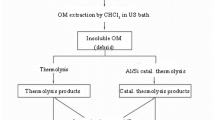Destruction of an oil alkane (paraffin) fraction by oil-destroying microorganisms was studied. The destruction rate was clearly dependent on the chain length. An increase in the number of alkanes with shorter chain lengths was indicative of the destruction of supramolecular oil structures and the oxidation of higher-molecular-mass compounds. Species and strain features of alkane destruction were found. Principal components analysis was used to show that Rhodococcus erythropolis and Acinetobacter guillouiae demonstrated different behaviors in the decomposition of alkanes. The oil destroyers were not capable of destroying all oil fractions with equal efficiencies. Based on previous studies, it could be confirmed that R erythropolis preferred the alkane fraction; A. guillouiae, the aromatic fraction.




Similar content being viewed by others
References
https://moneymakerfactory.respravochniklprognoz-po-dobyiche-nefti-v-2019.
B. M. Mirkin and L. G. Naumova, Zh. Obshch. Biol., 57, No. 3, 399-409 (1996).
Federal Law No. 7-FZ of Jan. 10,2002, “On environmental protection”; No. 287-FZ of Dec. 30, 2012, “On amendments to the Federal Laws ‘On the continental shelf of the Russian Federation” and ‘On inland sea waters, territorial sea and adjacent zone of the Russian Federation”’.
N.A. Rireeva, Biotechnology, No. 1, 51-54 (1996).
A. K. C. Kumar, B. S. Bisht, and V. D. Joshi, Int. J. Environ. Sci., 1, No. 6, 1079-1093 (2011).
B. A. Thapa, A. R. C. Kumar, and A. Ghimire, Kathmandu Univ. J. Sci., Eng. Technol., 8, No. 1, 164-170 (2012).
R. B. Seith12-Mulyakov, Informatika Ee Primen., 4, No. 1, 41-49 (2010).
Y. T. Liang, X. Zhang, J. Wang, et al., J. Hazard. Mater., 241, 371-378 (2012).
M. S. Zaki, O. M. Fawzi, and M. F. Abd El-Zaher, Life Sci. J., 10, No. 1, 3329-3332 (2013).
E. A. Rogozina, O. A. Andreeva, S. I. Zharkova, et al., Netegazov. Geol. Teor. Prakt., 5, No. 3, 1-18 (2010).
A. A. Vetrova, “Biodegradation of oil hydrocarbons by plasmid-containing destructive microorganisms,” Candidate Dissertation in Biological Sciences, Moscow, 2010.
I. B. Ivshina, R. A. Pshenichnov, and A. A. Oborin, Propane-Oxidizing Rhodococcus [in Russian], Izd. UNTs AN SSSR, Sverdlovsk, 1987, 123 pp.
D. V. Zhukov, V. P. Murygina, and S. V. Kalynzhnyi, Usp. Sovrem. Biol., 126, No. 3,285-296 (2006).
M. S. Tret’yakova, L. A. Belovezhets, and Yu. A. Markova, Sist. Metody Tekhnol, No. 4, 138-142 (2015).
M. S. Tret’yakova, L. A. Belovezhets, Yu. A. Markova, et al., Agrokhimiya, No. 12, 56-61 (2017).
L. A. Belovezhets, L. E. Mak arova, M. S. Tret2yakova, et al, Prikl. Biokhim. Mikrobiol, 53, No. 1, 76-81 (2017).
M. S. Tret2yakova, “Potential for use of endo- and rhizospheric microorganisms for reduction of oil-polluted soils,” Candidate Dissertation in Biological Sciences, Irkutsk, 2018.
A. A. Vetrova, V. A. Zabelin, A. A. Ivanova, et al., Yug Ross.: Ekol. Razvit., 13, No. 1, 184-197 (2018).
L. A. Belovezhets, M. S. Tret2yakova, B. A. Markova, et al., Aktual Biotekhnot, No. 3 (30), 514 (2019).
Acknowledgments
The work was performed using in vitro collections of microorganisms, cell cultures, and plants of the Bioresource Center Common Use Center, SIPPB, SB, RAS and material and technical resources of Baikal Analytical Common Use Center, SB, RAS.
Author information
Authors and Affiliations
Corresponding author
Additional information
Translated from Khimiya i Tekhnologiya Topliv i Masel, No. 6, pp. 48 — 52, November-December, 2020.
Rights and permissions
About this article
Cite this article
Belovezhets, L.A., Markova, Y.A., Tretyakova, M.S. et al. Destruction of an Oil Paraffin Fraction by Microorganisms. Chem Technol Fuels Oils 56, 919–925 (2021). https://doi.org/10.1007/s10553-021-01208-z
Published:
Issue Date:
DOI: https://doi.org/10.1007/s10553-021-01208-z




